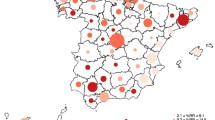Abstract
The associations between temperature and daily mortality was studied among the citizens of Oslo, Norway, 1990–1995. Data on daily mortality were linked with daily temperatures, relative humidity, wind velocity and air pollution. At temperatures below 10 °C, a 1 °C fall in the last 7 days average temperature increased the daily mortality from all diseases by 1.4%, respiratory diseases 2.1%, and cardiovascular diseases 1.7%. Above 10 °C, there was no statistically significant increase in daily mortality, except for respiratory mortality, which increased by 4.7% per 1 °C increase in the last 7 days average temperature. Daily mortality in Oslo increases with temperatures falling below 10 °C. The increase starts at lower temperatures than shown in warmer regions of the world, but at higher temperatures than in regions with even colder climates. As well insulated and heated dwellings are standard in Norway today, more adequate clothing during outdoor visits is probably the most important preventive measure for temperature related mortality.
Similar content being viewed by others
References
Rose G. Cold weather and ischaemic heart disease. Br J Prev Soc Med 1966; 20: 97–100.
Rogot E, Padgett SJ. Associations of coronary and stroke mortality withtemperature and snowfall in selected areas of the United States, 1962–1966. Am J Epidemiol 1976; 103: 565–575.
Bull GM, Morton J. Environment, temperature and deathrates. Age Ageing 1978; 7: 210–224.
Kunst AE, Looman CW, Mackenbach JP. Outdoor air temperature and mortality in The Netherlands: A time–series analysis. Am J Epidemiol 1993; 137: 331–341.
Gyllerup S, Lanke J, Lindholm LH, Schersten B. High coronary mortality in cold regions of Sweden. J Int Med 1991; 230: 479–485.
Auliciems A, Frost D. Temperature and cardiovascular deaths in Montreal. Int J Biometeorol 1989; 33: 151–156.
Frost DB, Auliciems A, de Freitas C. Myocardial infarct deathand temperature in Auckland, New Zealand. Int J Biometeorol 1992; 36: 14–17.
Eurowinter Group. Cold exposure and winter mortality from ischaemic heart disease, cerebrovascular disease, respiratory disease, and all causes, in warm and cold regions of Europe. Lancet 1997; 349: 1341–1346.
Gorjanc ML, Flanders WD, VanDerslice J, Hersh J, Malilay J. E. Effects of temperature and snowfall on mortality in Pennsylvania. Am J Epidemiol 1999; 149: 1152–1160.
Ballester F, Corella D, Perez-Hoyos S, Saez M, Hervas A. Mortality as a function of temperature. A study in Valencia, Spain, 1991–1993. Int J Epidemiol 1997; 26: 551–561.
Donaldson GC, Ermakov SP, Komarov YM, Mc-Donald CP, Keatinge WR. Early increases in ischaemic heart disease mortality dissociated from and later changes associated with respiratory mortality after cold weather in south east England. J Epidemiol Community Health 1997; 51: 643–648.
Donaldson GC, Tchernjavskii VE, Ermakov SP, Bucher K, Keatinge WR. Winter mortality and cold stress in Yekaterinburg, Russia: Interview survey. Br Med J 1998; 316: 514–518.
Donaldson GC, Ermakov SP, Komarov YM, Mc-Donald CP, Keatinge WR. Cold related mortalities and protection against cold in Yakutsk, eastern Siberia: Observation and interview study. Br Med J 1998; 317: 978–982.
Glattre E, Blix E. En vurdering av dødsårsaksstatistikken (Evaluation of the cause-of-death-statistics). Central Bureau of Statistics: Report 80/13 1980, ISBN:82-537-1136-0, Oslo, Norway.
Gedde-Dahl TW, Hansen R, Kleivan D, Klingberg MA, Lystad A. A new noti.cation system for infectious diseases in Norway. Some aspects of development and design of the MSIS. NIPH Ann 1978; 1: 43–50.
Hastie TJ, Tibshirani RJ. Generalized Additive Models. London: Chapman & Hall, 1990.
Health Effects Institute. Particulate air pollution and daily mortality. Analyses of the effects of weather and multiple air pollutants. The phase I.B report of the particle epidemiology evaluation project. Cambridge, MA: Health Effects Institute, 1997.
S-PLUS 4, MathSoft, Seattle, 1997.
Donaldson GC, Seemungal T, Jeffries DJ, Wedzicha JA. Effect of temperature on lung function and symptoms in chronic obstructive pulmonary disease. Eur Respir J 1999; 13: 844–849.
Keatinge WR, Coleshaw SRK, Cotter F, Mattock M, Murphy M, Chelliah R. Increases in platelet and red cell counts, blood viscosity, and arterial pressure during mild surface cooling: factors in mortality from coronary and cerebral thrombosis in winter. Br Med J 1984; 289: 1405–1408.
Neild PJ, Syndercombe-Court D, Keatinge WR, Donaldson GC, Mattock M, Caunce M. Cold-induced increases in erythrocyte count, plasma cholesterol and plasma fibrinogen of elderly people without a comparable rise in protein C or factor X. Clin Sci 1994; 86: 43–48.
Giesbrecht GG. The respiratory system in a cold environment. Aviat Space Environ Med 1995; 66: 890–902.
Eschenbacher WL, Moore TB, Lorenzen TJ, Weg JG, Gross KB. Pulmonary responses of asthmatic and normal subjects to di.erent temperature and humidity conditions in an environmental chamber. Lung 1992; 170: 51–62.
Koskela H, Tukiainen H. Facial cooling but not breathing of cold air induces bronchoconstriction: A study in asthmatic and healthy subjects. Eur Respir J 1995; 8: 2088–2093.
Woodhouse PR, Khaw K-T, Plummer M, Foley A, Meade TW. Seasonal variations of plasma fibrinogen and factor VII activity in the elderly: winter infections and deathfrom cardiovascular disease. Lancet 1994; 343: 435–439.
Rognerud M, Stensvold I. Oslohelsa. Report 1998, ISBN: 82-473-0005-2, Ullevaal Hospital, Oslo, Norway.
McMichael AJ, Anderson HR, Brunekreef B, Cohen AJ. Inappropriate use of daily mortality analyses to estimate longer-term mortality e.ects of air pollution. Int J Epidemiol 1999; 28: 990–992.
Oie L. The role of indoor building characteristics as exposure indicators and risk factors for development of bronchial obstruction in early childhood. Thesis 1998, ISBN:82-471-0247-1, Trondheim, Norway: Norwegian University of Science and Technology. Address for correspondence: Per Nafstad, Section of Epidemiology, Department of Population HealthSciences, National Institute of Public Health, P.O. Box 4404 Nydalen, 0403 Oslo, Norway Phone: +47-22042358; Fax: +47-22042351 E-mail: per.nafstad@folkehelsa.no 627
Author information
Authors and Affiliations
Rights and permissions
About this article
Cite this article
Nafstad, P., Skrondal, A. & Bjertness, E. Mortality and temperature in Oslo, Norway, 1990–1995. Eur J Epidemiol 17, 621–627 (2001). https://doi.org/10.1023/A:1015547012242
Issue Date:
DOI: https://doi.org/10.1023/A:1015547012242




